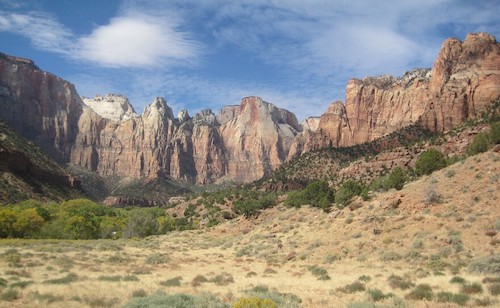Communiqué
Filled with grandeur, vibrance, and stunning scenery, “Call of the Canyon: Zion National Park” – Jan. 5 at 9 pm
< < Back toCall of the Canyon: Zion National Park
Thursday, January 5 at 9 p.m.
Zion National Park — a landscape formed over the course of 150 million years by the forces of geologic uplift and erosion, its vermillion cliffs stand today as a place of refuge and sanctuary, a glimpse at history through millennia. From its past as home to the Ancestral Puebloans and their descendants, the Southern Paiutes, to the more recent history of Mormon settlement and its current status as a National Park, Zion has inspired countless visitors to pass between its red sandstone walls.
Zion’s history of human settlement dates back nearly 8,000 years, when the Archaic groups inhabited the area. Next were the Ancestral Puebloans, whose pictographs can still be seen today along the canyon walls. The Southern Paiutes were known as the water people. They lived along the Virgin River — known as Pa’rus, meaning rushing or bubbling water in the Southern Paiute language — and were known as Pa’rus-its.
 Water has a specific meaning to members of the Southern Paiute tribe. As told by Shanandoah Anderson, Cultural Consultant, Shivwits Band of Paiutes:
Water has a specific meaning to members of the Southern Paiute tribe. As told by Shanandoah Anderson, Cultural Consultant, Shivwits Band of Paiutes:
“When our creation story began, there was nothing but water on this land. The whole world was water, and Ocean Woman was the only one — her daughter and the wolf and the coyote, those were the four creator beings that lived on the water. She created an island for them, and from there, she would scratch her skin and all of the dead skin would fall onto the ground, and from that she made the land. She created the earth, and she stretched it, and stretched it, and stretched it, and she would tell coyote and wolf to go out and tell her if it was big enough. And they would walk to the end of the earth and say, ‘no, it’s not big enough,’ so she stretched it and stretched it. So we came from the water to begin with, and because Ocean Woman created the land, she is our mother earth. So the water that flows through the land is her power, like her blood veins. Her veins are our life.”
The waters of the Virgin River brought a new group of settlers to the surrounding areas of Zion Canyon in the early 1860s: pioneers from the Church of Jesus Christ of Latter-day Saints. Among this early group of pioneers was settler Isaac Behunin, who is credited with giving the canyon its current name: Zion, meaning a place of survival and sanctuary.
Settlement and further exploration of Zion and surrounding areas brought with it a different kind of visitor — artists. In the 1860s and 1870s, expeditions led by John Wesley Powell introduced topographers, photographers, and artists such as Thomas Moran and Frederick S. Dellenbaugh to the wonders of the Colorado River Basin.
Dellenbaugh returned to the area in 1903 to pen an account of Zion Canyon for Scribner’s Magazine. Dellenbaugh wrote of Zion:
 “One hardly knows just how to think of it… There is almost nothing to compare to it. Niagara has the beauty of energy; the Grand Canyon, of immensity; the Yellowstone, of singularity; the Yosemite, of altitude; the ocean, of power; this Great Temple, of eternity“ – Frederick S. Dellenbaugh, Scribner’s Magazine, 1904.
“One hardly knows just how to think of it… There is almost nothing to compare to it. Niagara has the beauty of energy; the Grand Canyon, of immensity; the Yellowstone, of singularity; the Yosemite, of altitude; the ocean, of power; this Great Temple, of eternity“ – Frederick S. Dellenbaugh, Scribner’s Magazine, 1904.
Written accounts such as Dellenbaugh’s — and the photographs and vibrant paintings that accompanied them — soon caught the attention of people back east. In 1909 President William Howard Taft proclaimed the area Mukuntuweap National Monument, from the Southern Paiute word meaning “coming up out of the earth.” In 1919, the park’s name was changed to Zion, reportedly because acting Director of the National Park Service Horace Albright felt it would be easier to spell.
As early “tin-can” visitors came to experience the wonders of the park, Zion National Park’s acting supervisor, Walter Reusch, enhanced their experience with roads, lodges, and trails including the West Rim Trail, Walter’s Wiggles, and the safety chains on Angel’s Landing. Throughout the 1930s, as members of the Civilian Conservation Corps constructed bridges, tunnels, and even the park entrance signs, artists such as Maynard Dixon were at work painting the wide vistas and Navajo sandstone at which future generations would marvel.
Today, Utah’s most beloved national park sees more than four million visitors per year, the vast majority to what park Superintendent Jeff Bradybaugh calls the “front country.” While 90 percent of the land within the borders of Zion National Park is designated wilderness and sees little traffic, the remaining 10 percent is left to bear the brunt of the burden. Ever-increasing visitorship has led to changes within the park, from the introduction of the park shuttle system in 2000 to a new proposed development — formally known as the East Zion Initiative — that would set aside land near the park’s east entrance for future preservation and the construction of a second park visitor center.
Zion National Park faces no shortage of challenges in its second century, from issues surrounding congestion and lack of resources to questions over how to build a more inclusive future for the park. In the face of these and other challenges, Bradybaugh and his team refer back to the guiding mandate of the National Park Service: “To preserve unimpaired the natural and cultural resources and values of the National Park System for the enjoyment, education, and inspiration of this and future generations.”

